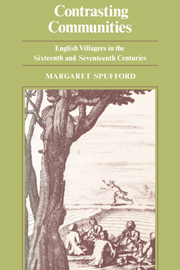Book contents
- Frontmatter
- Contents
- List of maps and graphs
- List of tables
- List of abbreviations
- Acknowledgements
- Dedication
- Introduction
- Map 1 Cambridgeshire: natural boundaries and soil types
- Map 2 Cambridgeshire: county and parish boundaries
- PART 1 People, Families and Land
- 1 The peopling of a county
- 2 The problem: the disappearance of the small landowner
- 3 The reality: the small landholder on the chalk: Chippenham
- 4 The reality: the small landholder on the clay: Orwell
- 5 The reality: the small landholder in the fens: Willingham
- General Conclusions to Part One
- PART 2 The Schooling of the Peasantry
- PART 3 Parishioners and their Religion
- Conclusion
- Appendix 1 The Butlers of Orwell
- Appendix 2 Notes on Graphs 3 and 5
- Index of Contemporary Names
- General Index
5 - The reality: the small landholder in the fens: Willingham
Published online by Cambridge University Press: 25 January 2010
- Frontmatter
- Contents
- List of maps and graphs
- List of tables
- List of abbreviations
- Acknowledgements
- Dedication
- Introduction
- Map 1 Cambridgeshire: natural boundaries and soil types
- Map 2 Cambridgeshire: county and parish boundaries
- PART 1 People, Families and Land
- 1 The peopling of a county
- 2 The problem: the disappearance of the small landowner
- 3 The reality: the small landholder on the chalk: Chippenham
- 4 The reality: the small landholder on the clay: Orwell
- 5 The reality: the small landholder in the fens: Willingham
- General Conclusions to Part One
- PART 2 The Schooling of the Peasantry
- PART 3 Parishioners and their Religion
- Conclusion
- Appendix 1 The Butlers of Orwell
- Appendix 2 Notes on Graphs 3 and 5
- Index of Contemporary Names
- General Index
Summary
Sources, fields, crops and stock
The parish of Willingham presents a complete and valuable contrast, both physically, and in the way it developed, to both Chippenham with its couple of hundred acres of fen, and the upland village of Orwell. Willingham had over 4,500 acres of territory, of which the arable of the three open fields took up only between 1,000 and 1,200 acres. This was less even than Orwell, which was a community under half the size of Willingham in 1563, and had over 1,400 acres of open-field arable. The territory of Willingham included one of the minor fen meres, of at least eighty acres, and part of a major one, and also had nearly 3,000 acres of fen. The village economy was therefore totally different from that based on arable farming in the other communities chosen for special study here.
The bishop of Ely had held the principal manor, which shortly after alienation from the see in 1600 came into the hands of Sir Miles Sandys. This corresponded with the parish, with the exception of the minute sub-manor of Burne, which contained only about a hundred acres of demesne and sixty acres of copyhold land. Sir Miles, who was knighted by James I and obtained a baronetcy in 1612, was one of the co-adventurers heavily involved with Francis, fourth earl of Bedford, in the draining of the Great Level. He had been engaged in private improvements on his own estates long before this major enterprise began in 1630.
- Type
- Chapter
- Information
- Contrasting CommunitiesEnglish Villages in the Sixteenth and Seventeenth Centuries, pp. 121 - 164Publisher: Cambridge University PressPrint publication year: 1974



